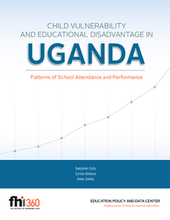In nations with high HIV/AIDS prevalence, how can policymakers identify and direct services towards the children most at risk of educational disadvantage? Previous research published by the Education Policy and Data Center (Smiley, et al., 2012) demonstrated that orphanhood is not necessarily a good predictor of low school enrollment in Lesotho, Malawi, Tanzania, Uganda, and Zambia, but that poverty and lack of adult care are associated with lower levels of educational access. This paper builds off of these findings by focusing in on Uganda and analyzing the extent to which official government “child vulnerability” indicators are associated with two important components of educational disadvantage: school enrollment and sixth grade learning outcomes. In addition to examining the government vulnerability categories, we explore the attendance and performance patterns for children and youth living in the urban slums.
Included in the official government categories of vulnerable children are orphans whose rights are not fulfilled, children with disabilities, abandoned/neglected/street children, children in child-headed households, and more.

